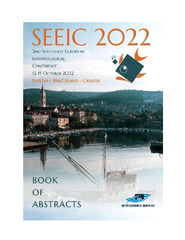Приказ основних података о документу
Transplant caging of seabream (Sparus aurata) as a monitoring tool for marine pollution assessment in the Montenegrin Adriatic coast
| dc.creator | Martinović, Rajko | |
| dc.creator | Kolarević, Stoimir | |
| dc.creator | Kračun-Kolarević, Margareta | |
| dc.creator | Đorđević Aleksić, Jelena | |
| dc.creator | Jovanović Marić, Jovana | |
| dc.creator | Gačić, Zoran | |
| dc.creator | Vuković-Gačić, Branka | |
| dc.creator | Perošević-Bajčeta, Ana | |
| dc.creator | Joksimović, Danijela | |
| dc.date.accessioned | 2023-10-25T11:15:33Z | |
| dc.date.available | 2023-10-25T11:15:33Z | |
| dc.date.issued | 2022 | |
| dc.identifier.isbn | 978-953-7914-10-3 | |
| dc.identifier.uri | http://radar.ibiss.bg.ac.rs/handle/123456789/5726 | |
| dc.identifier.uri | http://rimsi.imsi.bg.ac.rs/handle/123456789/2172 | |
| dc.description.abstract | More frequent application of biological parameters beside the conventional chemical parameters in national monitoring for marine ecosystem assessment is supported by UNEP/MAP. Accordingly, to evaluate the possible effects of pollution by determination of trace element content and genotoxicity assessment in marine organisms within the Boka Kotorska Bay, Montenegro (southern Adriatic), we carried a field study which included transplantation of the seabream (Sparus aurata) from aquaculture farm (Orahovac) to more impacted sites (Dobrota and port of Tivat), situated in vicinity of the main ports. On the sampling site Orahovac, the group of seabream specimens were placed in closed fish trap on 5 m depth (O1), another fish trap was placed in Dobrota, while the third fish trap with seabreams was placed at the site port of Tivat. The additional group was sampled from standard aquaculture cage on sampling site (O2) to reduce possible bias in genotoxicity data due to confined space within the fish trap. After two weeks of exposure, blood from fish heart was taken, afterwards muscle tissues were prepared for trace element determination. Genotoxicity was measured by DNA damage induction based on comet (single cell gel electrophoresis) assay parameter – Tail intensity (TI%), while trace element (As, Cd, Pb, Hg, Cr, Cu, Fe, Mn, Ni, Zn and V) content was determined by ICP. Mean values of TI% obtained from seabream specimens at the sampling site Orahovac were: 4.26 ± 0.17 – O1 and 2.56 ± 0.11 – O2, while TI% values for transplanted specimens on the sites Dobrota and port of Tivat were 6.38 ± 0.17 and 11.06 ± 0.23, respectively. Statistically significant differences (p<0,05) of TI% were observed between all specimens groups. The group of seabream from port of Tivat showed the highest TI% (higher level of DNA damage), most probably caused by marine pollution. Obtained trace element concentrations in seabream tissues were significantly lower in comparison to values recommended by FAO, EC and national legislatives of Croatia, Spain and Turkey. Since transplanted fish showed a significant response in a relatively short exposure period, our results support the introduction of seabream caging as monitoring tool to reveal marine pollution by multiple biomarker approach. Considering the significant share of aquacultured seabream in human consumption, higher availability for sampling and convenience in application for molecular biomarker analyses in the same samples, such an integrated monitoring approach would contribute to more credible data. | sr |
| dc.language.iso | en | sr |
| dc.publisher | Institute of Oceanography and Fisheries | sr |
| dc.rights | openAccess | sr |
| dc.source | 2nd Southeast European Ichthyological Conference (SEEIC); 2022 Oct 12-15; Brač Island, Croatia. Split: Institute of Oceanography and Fisheries | sr |
| dc.subject | Sparus aurata | sr |
| dc.subject | Montenegro | sr |
| dc.subject | pollution | sr |
| dc.subject | genotoxicity | sr |
| dc.subject | DNA damage | sr |
| dc.title | Transplant caging of seabream (Sparus aurata) as a monitoring tool for marine pollution assessment in the Montenegrin Adriatic coast | sr |
| dc.type | conferenceObject | sr |
| dc.rights.license | ARR | sr |
| dc.rights.holder | Institute of Oceanography and Fisheries | sr |
| dc.citation.spage | 33 | |
| dc.identifier.fulltext | http://rimsi.imsi.bg.ac.rs/bitstream/id/5781/bitstream_5781.pdf | |
| dc.identifier.rcub | https://hdl.handle.net/21.15107/rcub_rimsi_2172 | |
| dc.type.version | publishedVersion | sr |

